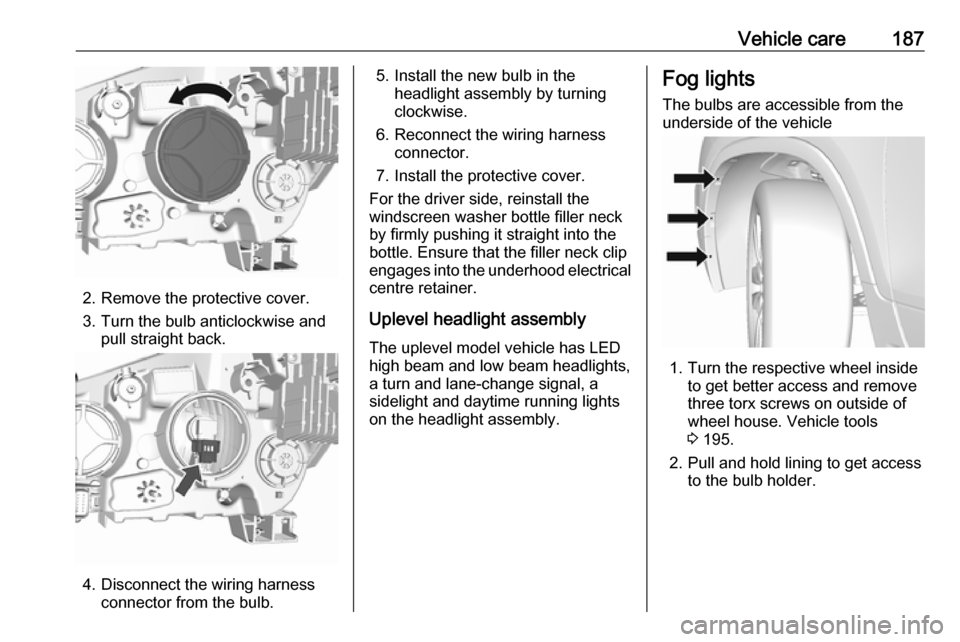bulb OPEL MOKKA X 2017 Manual user
[x] Cancel search | Manufacturer: OPEL, Model Year: 2017, Model line: MOKKA X, Model: OPEL MOKKA X 2017Pages: 247, PDF Size: 6.59 MB
Page 94 of 247

92Instruments and controlsIlluminates brieflyThe parking lights are switched on.
Flashes
A turn signal or the hazard warning flashers are activated.
Rapid flashing: failure of a turn signal
light or associated fuse, failure of turn
signal light on trailer.
Bulb replacement 3 186, Fuses
3 190.
Turn signals 3 122.
Seat belt reminder
Seat belt reminder on front seats
X for driver's seat illuminates or
flashes red in the instrument cluster.
k for front passenger seat illuminates
or flashes red in the centre console
when seat is occupied.
Illuminates
After the ignition has been switched on until the seat belt has been
fastened.Flashes
After having started the engine until
the seat belt has been fastened.
Seat belt status on rear seats
(vehicles with Midlevel display)
X illuminates or flashes white or grey
in the Driver Information Centre, after having started the engine.
Illuminates white
Seat belt is unfastened.
Illuminates grey
Seat belt has been fastened.
Flashes white or grey
Fastened seat belt has been
unfastened.
Fastening the seat belt 3 45.
Seat belt status on rear seats
(vehicles with Uplevel display)
X illuminates green or grey or flashes
yellow in the Driver Information
Centre, after having started the
engine.Illuminates grey
Seat belt is unfastened.
Illuminates green
Seat belt has been fastened.
Flashes yellow
Fastened seat belt has been
unfastened.
Fastening the seat belt 3 45.
Airbag and belt tensioners
v illuminates red.
When the ignition is switched on, the control indicator illuminates for a few
seconds. If it does not illuminate, does not go out after a few secondsor illuminates whilst driving, there is a
fault in the airbag system. Seek the
assistance of a workshop. The
airbags and belt pretensioners may
fail to trigger in the event of an
accident.
Deployment of the belt pretensioners
or airbags is indicated by continuous
illumination of v.
Page 175 of 247

Driving and operating173Trailer hitch
General information
Only use towing equipment that has
been approved for your vehicle.
Entrust retrofitting of towing
equipment to a workshop. It may be
necessary to make changes that
affect the cooling system, heat
shields or other equipment.
The bulb outage detection function for trailer brake light cannot detect a
partial bulb outage, e.g. in case of four
times five watt bulbs, the function only detects lamp outage when only a
single five Watt lamp remains or none remain.
Fitting of towing equipment could
cover the opening of the towing eye.
If this is the case, use the coupling ball
bar for towing. Always keep the
coupling ball bar in the vehicle when
not in use.Driving characteristics and
towing tips
Before attaching a trailer, lubricate
the coupling ball. However, do not do
so if a stabiliser, which acts on the coupling ball, is being used to reduce
snaking movements.
For trailers with low driving stability
and caravan trailers with a permitted
gross vehicle weight of more than
1000 kg a speed of 80 km/h must not
be exceeded; the use of a stabiliser is
recommended.
If the trailer starts snaking, drive more
slowly, do not attempt to correct the
steering and brake sharply if
necessary.
When driving downhill, drive in the
same gear as if driving uphill and
drive at a similar speed.
Adjust tyre pressure to the value
specified for full load 3 231.Trailer towing
Trailer loadsThe permissible trailer loads are
vehicle and engine-dependent
maximum values which must not be
exceeded. The actual trailer load is
the difference between the actual
gross weight of the trailer and the
actual coupling socket load with the trailer coupled.
The permissible trailer loads are
specified in the vehicle documents. In general, they are valid for gradients
up to max. 12%.
The permitted trailer loads apply up to
the specified incline and up to an
altitude of 1000 metres above sea
level. Since engine power decreases
as altitude increases due to the air
becoming thinner, therefore reducing
climbing ability, the permissible gross train weight also decreases by 10%
for every 1000 metres of additional
altitude. The gross train weight does
not have to be reduced when driving
on roads with slight inclines (less than
8%, e.g. motorways).
Page 179 of 247

Vehicle care177Vehicle careGeneral Information...................177
Accessories and vehicle modifications .......................... 177
Vehicle storage ........................178
End-of-life vehicle recovery .....178
Vehicle checks ........................... 179
Performing work ......................179
Bonnet ..................................... 179
Engine oil ................................. 180
Engine coolant ......................... 181
Power steering fluid .................181
Washer fluid ............................ 182
Brakes ..................................... 182
Brake fluid ............................... 182
Vehicle battery ......................... 183
Diesel fuel system bleeding .....184
Wiper blade replacement ........185
Bulb replacement .......................186
Halogen headlights ..................186
Fog lights ................................. 187
Tail lights ................................. 188
Number plate light ...................189
Electrical system ........................190
Fuses ....................................... 190
Engine compartment fuse box . 190Instrument panel fuse box .......192
Load compartment fuse box ....194
Vehicle tools .............................. 195
Tools ........................................ 195
Wheels and tyres .......................196
Winter tyres ............................. 196
Tyre designations ....................196
Tyre pressure .......................... 196
Tyre pressure monitoring system .................................... 197
Tread depth ............................. 201
Changing tyre and wheel size . 202
Wheel covers ........................... 202
Tyre chains .............................. 202
Tyre repair kit .......................... 203
Wheel changing .......................206
Spare wheel ............................ 208
Jump starting ............................. 210
Towing ....................................... 212
Towing the vehicle ...................212
Towing another vehicle ...........213
Appearance care .......................214
Exterior care ............................ 214
Interior care ............................. 216General Information
Accessories and vehicle modifications
We recommend the use of genuine
parts and accessories and factory
approved parts specific for your
vehicle type. We cannot assess or
guarantee reliability of other products
- even if they have a regulatory or
otherwise granted approval.
Any modification, conversion or other
changes made to standard vehicle
specifications (including, without
limitation, software modifications,
modifications of the electronic control units) may invalidate the warrantyoffered by Opel. Furthermore, such
changes may impact fuel
consumption, CO 2 emissions and
other emissions of the vehicle and
cause the vehicle to no longer
conform to the type approval,
impacting the validity of your vehicle
registration.
Page 188 of 247

186Vehicle careBulb replacement
Switch off the ignition and turn off the relevant switch or close the doors.
Only hold a new bulb at the base. Do
not touch the bulb glass with bare
hands.
Use only the same bulb type for
replacement.
Replace headlight bulbs from within
the engine compartment.
Note
After driving in heavy rain or after
washing, some exterior light lenses
could appear frosty.
This condition is caused by the
temperature difference between the
inside and outside of the light.
This is similar to the condensation
on your windows inside your vehicle during the rain and doesn't indicate
a problem with your vehicle.
If the water leaks into the light bulb
circuitry, have the vehicle checked
by your authorised workshop.Halogen bulbs9 Warning
Halogen bulbs have pressurized
gas inside and can burst if you
drop or scratch the bulb. You or others could be injured. Be sure to read and follow the instructions onthe bulb package.
LED lighting
This vehicle has several LED lights.
For replacement of any LED lighting
assembly, contact a workshop.
Halogen headlights
Baselevel headlight assembly
The base model vehicle has halogen
high beam and low beam headlights,
an LED turn and lane-change signal,
a sidelight and daytime running lights on the headlight assembly.
Passenger side shown, driver side
similar.
On the driver side remove the
windscreen washer bottle filler neck,
before changing a bulb.
1. High beam headlights
2. Low beam headlights
High beam and low beam headlights 1. Open the bonnet. Bonnet 3 179
Page 189 of 247

Vehicle care187
2. Remove the protective cover.
3. Turn the bulb anticlockwise and pull straight back.
4. Disconnect the wiring harnessconnector from the bulb.
5. Install the new bulb in theheadlight assembly by turning
clockwise.
6. Reconnect the wiring harness connector.
7. Install the protective cover.
For the driver side, reinstall the
windscreen washer bottle filler neck
by firmly pushing it straight into the
bottle. Ensure that the filler neck clip
engages into the underhood electrical centre retainer.
Uplevel headlight assembly The uplevel model vehicle has LED
high beam and low beam headlights, a turn and lane-change signal, asidelight and daytime running lights
on the headlight assembly.Fog lights
The bulbs are accessible from the
underside of the vehicle
1. Turn the respective wheel inside to get better access and remove
three torx screws on outside of
wheel house. Vehicle tools
3 195.
2. Pull and hold lining to get access to the bulb holder.
Page 190 of 247

188Vehicle care
3.Pull the retaining rib outwards and
remove plug connector from the
bulb socket.
4. Turn the bulb holder anticlockwise
and remove it from the reflector.
5. Remove and replace the bulb socket with bulb and attach the
plug connector.
6. Insert the bulb socket into the reflector by turning clockwise and
engage.
7. Re-assemble the lining and fasten
the three torx screws.
Tail lights
The vehicle has halogen turn and lane-change signals, a back-up light
and LED tail/stop lights on the tail light
assembly.
Left-hand side
1. Disengage both covers at the respective outer side by inserting
a screwdriver. Remove both
covers and unscrew screws.
Remove the panel.
2. First disengage cover by inserting
a screwdriver at the recess. Then
disengage cover at the front and
upper side. Remove cover.
Page 191 of 247

Vehicle care189Right-hand side
1.Remove the storage door and the
tyre repair kit.
2. Remove the cover.
3. Turn and lane-change signal light (1)
Back-up light (2)
4. Remove bulb holder. Remove and renew bulb.
5.Insert bulb holder into the tail light
assembly. Install tail light
assembly in body and tighten.
Close covers and engage.
6. Switch on ignition, operate and check all lights.
Number plate light
1. Prise the light out with a screwdriver.
2. Remove bulb housing downwards, taking care not to pull
on the cable.
Rotate bulb holder anticlockwise
to disengage.
Page 192 of 247

190Vehicle care3. Remove bulb from holder andrenew bulb.
4. Insert bulb holder in bulb housing and rotate clockwise.
5. Insert bulb housing and secure using a screwdriver.Electrical system
Fuses
Data on the replacement fuse must match the data on the defective fuse.
In a box above the positive terminal of
the battery are some main fuses. If
necessary have them changed by a
workshop.
Before replacing a fuse, turn off the
respective switch and the ignition.
A blown fuse can be recognised by its melted wire. Do not replace the fuse
until the cause of the fault has been
remedied.
Some functions are protected by
several fuses.
Fuses may also be inserted without existence of a function.
Note
Not all fuse box descriptions in this
manual may apply to your vehicle.
When inspecting the fuse box, refer to the fuse box label.Fuse extractor
A fuse extractor may be located in the fuse box in the engine compartment.
Place the fuse extractor on the
various types of use from the top or
side, and withdraw fuse.
Engine compartment fusebox
The fuse box is in the engine
compartment.
Disengage the cover, lift it upwards
and remove.
Page 242 of 247

240IndexAAccessories and vehicle modifications .......................... 177
Adaptive forward lighting .....96, 119
Adjustable air vents ...................131
Airbag and belt tensioners ...........92
Airbag deactivation ................52, 93
Airbag label................................... 47 Airbag system .............................. 47
Air conditioning regular operation ................................ 132
Air conditioning system .............. 127
Air intake .................................... 131
Air vents...................................... 131
All-wheel drive ........................... 147
Antilock brake system ................ 148
Antilock brake system (ABS) .......93
Anti-theft alarm system ................30
Anti-theft locking system .............. 30
Appearance care ........................214
Automatic anti-dazzle ..................34
Automatic light control ...............116
Automatic locking ........................28
Automatic transmission .............143
Autostop ..................................... 138
Auxiliary heater ........................... 130
B Battery discharge protection ......125
Battery voltage ........................... 104Bicycle rack .................................. 61
Bonnet ....................................... 179
Brake and clutch fluid .................218
Brake and clutch system .............93
Brake assist ............................... 149
Brake fluid .................................. 182
Brakes ............................... 148, 182
Breakdown.................................. 212
Bulb replacement ....................... 186
C
Capacities .................................. 230
Catalytic converter .....................142
Central locking system ................24
Centre console storage ...............61
Changing tyre and wheel size ...202
Charging system .......................... 93
Child locks ................................... 29
Child restraint installation locations ................................... 54
Child restraints.............................. 53
Child restraint systems ................53
Climate control ............................. 16
Climate control systems .............126
Clock............................................. 81
Code ........................................... 103
Collision damage repair ..............235
Control indicators.......................... 87
Control of the vehicle .................134
Controls ........................................ 77